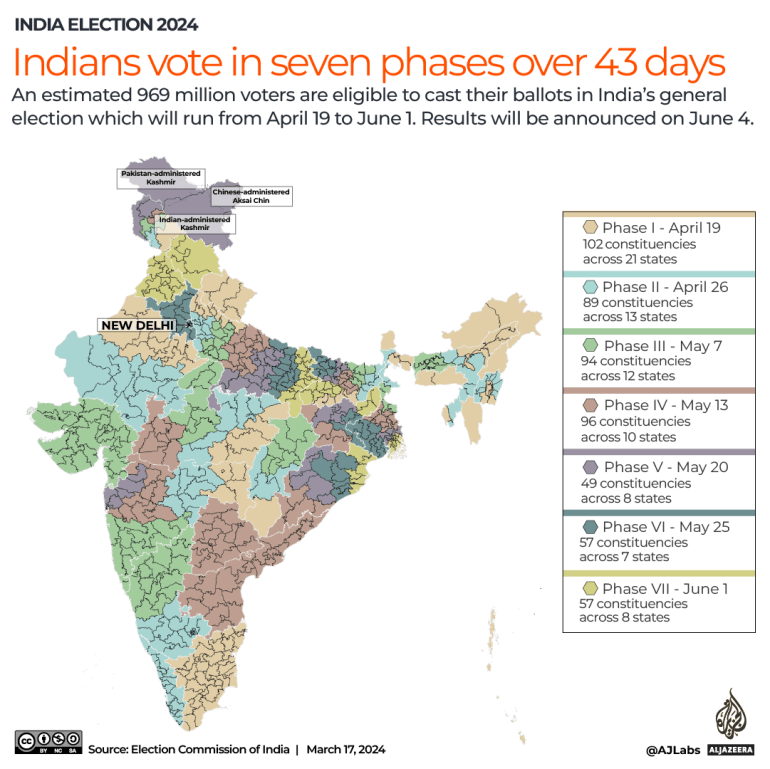India election 2024: Which are the main political parties in the fray?
India will kick off the world’s largest democratic exercise on Friday, with 969 million registered voters casting the ballot to elect 543 members of the Lok Sabha, India’s lower house of parliament over seven phases starting April 19.
The world’s most populous country has more than 2,500 political parties, but a mere 10 of them currently hold 86 percent of the seats in the Lok Sabha.
Here is a look at the main parties vying for the Lok Sabha seats this year:
Bharatiya Janata Party (BJP)
Incumbent Prime Minister Narendra Modi’s BJP claims to be the world’s largest political organisation, with almost 180 million members.
The BJP was born in 1980 out of the Bharatiya Jana Sangh party, an offshoot of the far-right Hindu nationalist organisation, the Rashtriya Swayamsevak Sangh (RSS).
The RSS, formed in 1925 along the lines of European ethnonationalism movements and fascist parties, wants India to be defined as a Hindu nation. Today, the secretive men-only organisation is the ideological fountainhead of dozens of Hindu right-wing groups, including the BJP, and counts Modi and many top BJP leaders as its lifetime members.
The BJP was founded shortly after the controversial imposition of a state of emergency by the then Prime Minister Indira Gandhi of the Congress in 1975. Atal Bihari Vajpayee, a prominent Bharatiya Jana Sangh leader, opposed the emergency – a plank that brought a coalition of anti-Congress parties to power in 1977.
But the alliance collapsed in two years due to political infighting and Vajpayee formed the BJP in 1980 with his close aide, Lal Krishna Advani. In 1996, Vajpayee became the first BJP prime minister but his government only lasted 13 days. He returned to power for 13 months in 1998-1999 and then from 1999 to 2004 – the first non-Congress prime minister to serve a complete term.
Modi, 73, born and raised in the western state of Gujarat, has been an RSS member since his 20s. He was also in the Bharatiya Jana Sangh before it became the BJP. Modi rose through the ranks over the years and was the chief minister of Gujarat for more than a decade.
In 2014, Modi led the BJP to form its first-ever majority government on its own and he has been in power since. He is seeking a third term through re-election from Varanasi, a city in the northern Uttar Pradesh state, which holds religious significance for the Hindu majority.
![[Al Jazeera]](https://www.aljazeera.com/wp-content/uploads/2024/03/INTERACTIVE_INDIA_ELECTION_MAR16_2024_1-copy-4-1710309759.png?w=770&resize=770%2C770)
Indian National Congress
Congress is India’s oldest political party, dating back to 1885 when the British ruled over the Indian subcontinent. The “grand old party” has governed India for more than two-thirds of the years since its independence in 1947, with its Western-educated Prime Minister Jawaharlal Nehru credited with laying its liberal and secular foundations.
Nehru’s daughter Indira Gandhi was India’s first and only female prime minister. The Congress also introduced landmark economic reforms in 1991, making the way for the evolution of an open market economy.
But the Congress has struggled after Modi swept to power in 2014.
Rahul Gandhi, Modi’s fiercest opponent and Congress’s star campaigner, quit as the party chief after a miserable performance in the last parliamentary polls in 2019. Yet, the 53-year-old four-time parliament member remains at the centre of India’s opposition politics and Modi’s main target.
A scion of the Gandhi-Nehru dynasty, his father Rajiv Gandhi, grandmother Indira and great-grandfather Nehru were all prime ministers and led the country for more than 37 years.
Gandhi is the main face of the Congress-led 26-member opposition alliance, named the Indian National Developmental Inclusive Alliance (INDIA). He organised two cross-country marches to invigorate his election campaign and tap into discontent over rural distress, unemployment and income inequality.
Gandhi is contesting this year’s election from Wayanad in the southern state of Kerala.
Aam Aadmi Party (AAP)
The Aam Aadmi Party ,or Common Person’s Party, rose from a potent anticorruption movement in 2011 amid protests led by Anna Hazare – a self-styled crusader backed by close aide Arvind Kejriwal. For this election, the AAP is part of the INDIA alliance.
Kejriwal, a staunch Modi critic, founded the AAP in 2012 and formed a state government in the national capital region of Delhi in 2015, staging an unexpected political upset for established parties like the BJP and Congress. Kejriwal has been the chief minister of Delhi since. The party also runs Punjab state.
However, AAP’s prospects this year are clouded by pre-election arrests of several of its high-profile leaders, including Kejriwal, in an alleged corruption case. The party dismisses the allegations as “a desperate attempt to malign the image” of Kejriwal for political gains.

Dravida Munnetra Kazhagam (DMK)
A strong regional force in India’s south, the DMK is India’s third-largest party in terms of the number of seats it holds in the lower house of parliament.
A Congress ally, DMK also runs the southern state of Tamil Nadu, which boasts of a high literacy rate and other development indices.
All India Trinamool Congress (TMC)
India’s fourth-largest party by seats in parliament, the Trinamool Congress holds power in West Bengal, another state where the BJP has struggled to consolidate its power.
The TMC splintered from the Congress and came into being nearly 25 years ago. The party’s founder, Mamata Banerjee, has been the head of West Bengal state for about 13 years and is now a reluctant Congress ally in fighting the BJP in the 2024 polls. Her party has joined INDIA, but has failed to agree on who will fight from which seat in the eastern state.
One of the TMC candidates for the election is Mahua Moitra, a persistent critic of Modi, who was expelled from parliament last year over bribery allegations.




